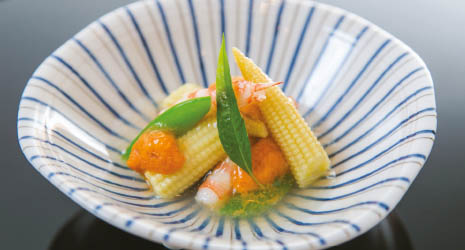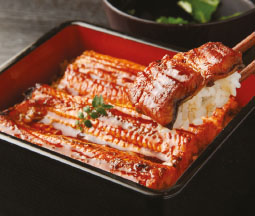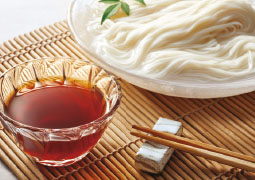Home > Highlighting JAPAN > Highlighting Japan August 2018 > How to Enjoy Summer in Japan
Highlighting JAPAN


Japan’s Summer Food and Dining Wisdom
For centuries, Japanese people have used various bits of knowledge and folk wisdom to stave off the summer heat. Here are some foods and dining hints passed down for generations that can help you survive and even thrive during summer in Japan.
Almost every region of Japan endures stifling heat and humidity in summer, and so the knowledge of which foods help fight off the summer heat is firmly rooted here. Summer vegetables such as eggplant, cucumber and melon, for example, can reduce heat built up inside the body and are commonly eaten in summer.
“The main ingredient in today’s recipe, spaghetti squash, is an oval-shaped, yellow gourd vegetable reportedly effective at cooling the body,” says Sadaharu Nakajima, owner and chef of Japanese cuisine at Shinjuku Kappo Nakajima. “If you want to beat the hot weather, it’s essential to eat things that are in season. And while it depends on the customers and the restaurant, we often serve cold things in the summer.”
Chef Nakajima has made two summer dishes to sample. The first is midsummer shijimi clams and spaghetti squash in white vinegar the refreshing bite of the vinegar and soy sauce dressing and Sichuan peppers reinvigorate heat-fatigued bodies. Summer shijimi clams known as “midsummer shijimi clams” are a seasonal ingredient. The second dish is summer vegetables and seafood with a gelée of kombu dashi broth, which makes use of a cold, simply flavored kombu gelée.
According to cooking expert and registered dietitian Yukari Igarashi, consuming these two dishes offers various health benefits.
“The spaghetti squash is rich in potassium, which can reduce excess heat stored in the body,” Igarashi states. “Shijimi clams are rich in protein and contain many different minerals, so they’re considered effective at staving off heat exhaustion. There’s even an old saying, ‘Midsummer clams are stomach medicine,’ which proves just how much they have been consumed in summer for so long. The vinegar improves intestinal function and controls the incidence of free radicals which can be a source of fatigue leading to a body more resistant to exhaustion. The Japanese tiger prawn used in the second dish has protein, and the young corn has vitamin C, both of which lead to a stronger immune system.”
Igarashi adds that there is no way long-ago generations understood why it’s good to eat summer vegetables and midsummer shijimi clams in summer the way modern people do, since nutritional science didn’t exist then.
“However, we have old sayings such as ‘Eat the first product of the season and you’ll live 75 days longer’ and ‘To eat the first product of the season brings a good omen,’ which prove that our ancestors ate seasonal foods. They couldn’t obtain vegetables regardless of season the way we can now, so it was natural for them to eat the highly nutritional foods in season, which we can guess was connected to preserving health,” Igarashi notes.
Somen noodles are a cold food often seen on family dining tables in Japan. The long, thin noodles made of kneaded wheat flour slide easily down the throat and are a popular summertime dish.
Eel is another type of food often eaten in summer. According to Chef Nakajima, this is because in the Edo period (1603-1867), Hiraga Gennai (1728-79)*1 recommended that people eat eel on the Midsummer Day of the Ox*2. “This is a leading theory, but eels are in season from fall to winter, so I think they taste best then,” he adds.
Another characteristic of Japanese summertime foods is that they are arranged on plates with colors that are cool and refreshing to the eye.
“In the summer we use glass dishes as well as ceramic plates that give off a cooling aura, such as Arita ware, which has a trademark translucent quality. We also pay attention to color, and we recommend choosing white and green tableware for their cooling aspect,” Chef Nakajima explains.
To get through the sizzling Japanese summer, we recommend that you eat lots of summertime seasonal foods while enjoying how refreshing they look on the plate.
*1 Hiraga Gennai was a man of many faces—a geologist, Dutch scholar, ballad and drama writer, inventor and copywriter.
*2 The Midsummer Day of the Ox is a day based on the old Japanese calendar.
© 2009 Cabinet Office, Government of Japan








